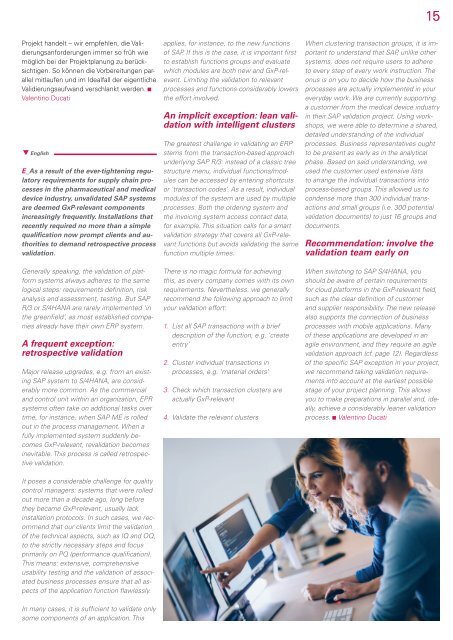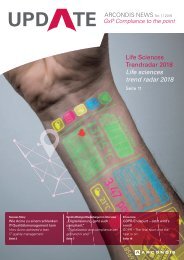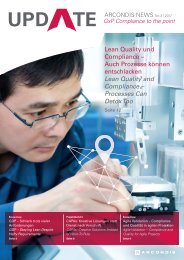ARCONDIS UPDATE No. 02|2019: The smarter solution
ARCONDIS Kundennewsletter für die Themenbereiche Business Applications und Compliance in Life Sciences Unternehmen
ARCONDIS Kundennewsletter für die Themenbereiche Business Applications und Compliance in Life Sciences Unternehmen
You also want an ePaper? Increase the reach of your titles
YUMPU automatically turns print PDFs into web optimized ePapers that Google loves.
15<br />
Projekt handelt – wir empfehlen, die Validierungsanforderungen<br />
immer so früh wie<br />
möglich bei der Projektplanung zu berücksichtigen.<br />
So können die Vorbereitungen parallel<br />
mitlaufen und im Idealfall der eigentliche<br />
Validierungsaufwand verschlankt werden.<br />
Valentino Ducati<br />
English<br />
E_As a result of the ever-tightening regulatory<br />
requirements for supply chain processes<br />
in the pharmaceutical and medical<br />
device industry, unvalidated SAP systems<br />
are deemed GxP-relevant components<br />
increasingly frequently. Installations that<br />
recently required no more than a simple<br />
qualification now prompt clients and authorities<br />
to demand retrospective process<br />
validation.<br />
Generally speaking, the validation of platform<br />
systems always adheres to the same<br />
logical steps: requirements definition, risk<br />
analysis and assessment, testing. But SAP<br />
R/3 or S/4HANA are rarely implemented ‘in<br />
the greenfield’, as most established companies<br />
already have their own ERP system.<br />
A frequent exception:<br />
retrospective validation<br />
Major release upgrades, e.g. from an existing<br />
SAP system to S/4HANA, are considerably<br />
more common. As the commercial<br />
and control unit within an organization, EPR<br />
systems often take on additional tasks over<br />
time, for instance, when SAP ME is rolled<br />
out in the process management. When a<br />
fully implemented system suddenly becomes<br />
GxP-relevant, revalidation becomes<br />
inevitable. This process is called retrospective<br />
validation.<br />
It poses a considerable challenge for quality<br />
control managers: systems that were rolled<br />
out more than a decade ago, long before<br />
they became GxP-relevant, usually lack<br />
installation protocols. In such cases, we recommend<br />
that our clients limit the validation<br />
of the technical aspects, such as IQ and OQ,<br />
to the strictly necessary steps and focus<br />
primarily on PQ (performance qualification).<br />
This means: extensive, comprehensive<br />
usability testing and the validation of associated<br />
business processes ensure that all aspects<br />
of the application function flawlessly.<br />
applies, for instance, to the new functions<br />
of SAP. If this is the case, it is important first<br />
to establish functions groups and evaluate<br />
which modules are both new and GxP-relevant.<br />
Limiting the validation to relevant<br />
processes and functions considerably lowers<br />
the effort involved.<br />
An implicit exception: lean validation<br />
with intelligent clusters<br />
<strong>The</strong> greatest challenge in validating an ERP<br />
stems from the transaction-based approach<br />
underlying SAP R/3: instead of a classic tree<br />
structure menu, individual functions/modules<br />
can be accessed by entering shortcuts<br />
or ‘transaction codes’. As a result, individual<br />
modules of the system are used by multiple<br />
processes. Both the ordering system and<br />
the invoicing system access contact data,<br />
for example. This situation calls for a smart<br />
validation strategy that covers all GxP-relevant<br />
functions but avoids validating the same<br />
function multiple times.<br />
<strong>The</strong>re is no magic formula for achieving<br />
this, as every company comes with its own<br />
requirements. Nevertheless. we generally<br />
recommend the following approach to limit<br />
your validation effort:<br />
1. List all SAP transactions with a brief<br />
description of the function, e.g. ‘create<br />
entry’<br />
2. Cluster individual transactions in<br />
processes, e.g. ‘material orders’<br />
3. Check which transaction clusters are<br />
actually GxP-relevant<br />
4. Validate the relevant clusters<br />
When clustering transaction groups, it is important<br />
to understand that SAP, unlike other<br />
systems, does not require users to adhere<br />
to every step of every work instruction. <strong>The</strong><br />
onus is on you to decide how the business<br />
processes are actually implemented in your<br />
everyday work. We are currently supporting<br />
a customer from the medical device industry<br />
in their SAP validation project. Using workshops,<br />
we were able to determine a shared,<br />
detailed understanding of the individual<br />
processes. Business representatives ought<br />
to be present as early as in the analytical<br />
phase. Based on said understanding, we<br />
used the customer used extensive lists<br />
to arrange the individual transactions into<br />
process-based groups. This allowed us to<br />
condense more than 300 individual transactions<br />
and small groups (i.e. 300 potential<br />
validation documents) to just 16 groups and<br />
documents.<br />
Recommendation: involve the<br />
validation team early on<br />
When switching to SAP S/4HANA, you<br />
should be aware of certain requirements<br />
for cloud platforms in the GxP-relevant field,<br />
such as the clear definition of customer<br />
and supplier responsibility. <strong>The</strong> new release<br />
also supports the connection of business<br />
processes with mobile applications. Many<br />
of these applications are developed in an<br />
agile environment, and they require an agile<br />
validation approach (cf. page 12). Regardless<br />
of the specific SAP exception in your project,<br />
we recommend taking validation requirements<br />
into account at the earliest possible<br />
stage of your project planning. This allows<br />
you to make preparations in parallel and, ideally,<br />
achieve a considerably leaner validation<br />
process. Valentino Ducati<br />
In many cases, it is sufficient to validate only<br />
some components of an application. This














